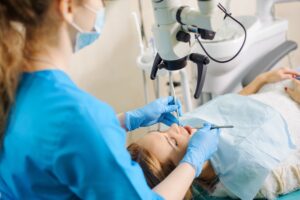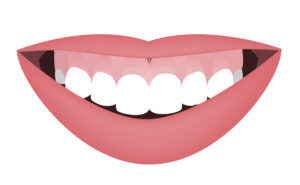Header logo
header top contact widget
Tooth Loss
Pregnancy Gingivitis Can Affect More Than The Mother’s Health
Posted on Jul 14, 2022 by William J. Claiborne, DDS MS
Is there any other time in a female’s life when they must be as health conscious as during pregnancy?
Pregnant women, it seems, are given a long list of guidelines to follow… What they should not eat or drink, what medications to avoid, and even down to what beauty products to give up. Yet, the 9 months of discipline is well worth the greater potential to bring a healthy baby into the world.
Along with the other health guidelines, obstetricians are now urging pregnant women to pay particular attention to their oral health. For decades, research has tracked a correlation between inflammatory bacteria in the mouth to a number of serious health problems, including many far beyond the mouth.
Once the infectious bacteria of gum disease enter the bloodstream (typically through tears in weakened gum tissues), it can trigger inflammatory reactions, many serious and some that can have deadly consequences. It is the nation’s’ leading cause of adult tooth loss and has been linked to heart disease, stroke, some cancers, diabetes, arthritis, high blood pressure and impotency.
However, because of their susceptibility, the risk for full-blown gum disease is higher for pregnant females with nearly a third developing gum disease. Yet, it’s not just the oral (and overall) health of the mother that can be affected.
Research has shown that gum disease increases the risk for pre-term delivery (prior to 37 weeks) and babies of low birth weight (less than 5.5 lbs.). One study showed the preterm birth rate for females without gum disease to be approximately 11% compared to nearly 29% for pregnant women with moderate to severe periodontal disease.
One study showed that pregnant women with gum disease were 4 – 7 times more likely to deliver prematurely (before week 37) and underweight babies than mothers with healthy gums. Too, the women with the most severe periodontal (gum) disease delivered most prematurely, at 32 weeks.
Other findings show that gum disease increases the risks of late-term miscarriage and pre-eclampsia. When oral bacteria reach placental membranes via the bloodstream, inflammatory reactions can trigger pre-eclampsia or early labor.
In one study, for example, pregnant females with higher blood levels of antibodies to oral bacteria also had higher rates of preterm birth and babies of low birth weight. These elevated antibodies have been found in amniotic fluid and fetal cord blood samples of infants who were preterm or of low birth weight at birth.
Oral problems in pregnant females can begin even when the mother-to-be is following the same oral hygiene routine as they have previously. The greater susceptibility can be blamed on fluctuating hormone levels during pregnancy. These changes increase the risk for gingivitis (inflammation of the gums) and periodontal disease.
This is why approximately 40% of women develop gingivitis during pregnancy, known as pregnancy gingivitis. Pregnancy gingivitis is a mild form of gum disease that causes gums to become swollen, tender and bleed easily when brushing.
This is the result of an increased level of progesterone in pregnancy, which makes oral bacterial growth easier. Progesterone also makes gum tissues more sensitive to plaque. For those who have significant gum disease prior to pregnancy, being pregnant can make the condition worse.
Gum inflammation typically appears between months 2 and 8 of pregnancy. Signs of pregnancy gingivitis range from gums that are red rather than a healthy pink. Gums will often bleed when brushing teeth and be swollen and tender in spots.
The goal is to prevent pregnancy gingivitis before it occurs. Be committed to a thorough oral hygiene regimen at home, which includes brushing twice a day, flossing daily and swishing with an antimicrobial mouth rinse. Be sure to keep your 6-month cleanings and exams. These will remove any plaque buildup that has occurred between visits.
A periodontist has specialized training in the diagnosis and treatment of all levels of gum disease – in a way that is safe for pregnant women (as well as all patients). Signs and symptoms of gum disease include gums that bleed when brushing, frequent bad breath, swollen or tender gums, gums that loosen or pull away from the base of teeth, or gums that darken in color.
If you have any of these symptoms (whether pregnant or not), you are urged to schedule an appointment at your earliest convenience. Call our Asheville periodontal dental office at 828-274-9440 to arrange an examination to begin.
Our Asheville Periodontal Dental Office Offers Some Unique Services
Posted on Jun 13, 2022 by William J. Claiborne, DDS MS
As a Periodontist in Asheville, I’ve helped hundreds of patients overcome periodontal (gum) disease and the many repercussions that come with tooth loss. Helping to save teeth that were on the verge of requiring removal has also been a victory for the patient as well as me.
 I take great pride in being a part of the transformations of patients who achieve healthy, confident smiles. This is why I’ve created an environment that affords every patient with the most advanced options available for restoring oral health and replacing lost teeth with dental implants.
I take great pride in being a part of the transformations of patients who achieve healthy, confident smiles. This is why I’ve created an environment that affords every patient with the most advanced options available for restoring oral health and replacing lost teeth with dental implants.
Let me begin by clarifying the benefits our periodontal office brings…
• A periodontist has advanced training to properly diagnose and treat all stages of gum disease.
• We are known for never over-treating or under-treating with a commitment to provide the most successful treatment for each patient’s specific needs.
• Our periodontal office is specially equipped for the diagnosis and treatment of all stages of gum disease as well as placement of dental implants.
• Diagnosis and treatment planning is backed by an immense array of advanced technology, including:
-
- LANAP (Laser-Assisted New Attachment Procedure) with PerioLase MVP 7 – an advanced protocol that efficiently and effectively treats advanced gum disease with the added advantages of a dental laser. This offers a non-surgical alternative for patients with moderate to severe periodontal disease and has even been found to stimulate bone regrowth in damaged areas.
- 3-D Cone Beam Imaging – is ideal for diagnoses and treatment planning through images that provide a clear view of the upper and lower jaw (including nerve canals), with rotations that show sagittal, axial, and coronal planes in a process that is quick, painless and at minimal radiation levels.
- CareStream Cone Beam Computer Tomography Imaging – is enhanced tomography that works with 3D imaging for exceptional detail and range.
- CS 3600 Intraoral Scanner – quickly and comfortably captures digital impressions to accurately and easily create precision models or appliances (crowns, inlays, onlays, bridges, orthodontic appliances, aligners, custom abutments) without the need for bulky, goopy trays.
- Computerized Dental Implant Placement – an advanced system for pre-surgical positioning of dental implants using a 3D model of the patient’s jaw. Once the implant type is selected, a template is developed for optimal treatment success.
• A commitment to comfort including I.V. sedation (twilight sleep) as well as oral sedation for total relaxation. On our team is a Board Certified Anesthesiologist to provide sedation and anesthesia for optimal comfort and safety.
Treatment options in our specialty dental office also include reshaping gum tissues for esthetic enhancement (crown lengthening, gingivectomy for ‘gummy smiles’, repairing areas of gum recession); diagnosis and placement of dental implants; and treatment of lesions or cysts in oral tissues.
With specialized skills, a periodontist is especially respectful to oral tissues as tender layers that significantly affect the appearance of a smile and the health of teeth. Utilizing special skills to minimize incisions while effectively treating each area in the mouth, a periodontist is your expert.
Call 828-274-9440 to learn more or to schedule a consultation appointment. New patients are always welcome and a referral is not required.
How Losing Natural Teeth Can Lead To Changes In Facial Appearance
Posted on Jun 01, 2022 by William J. Claiborne, DDS MS
If you’ve worn dentures or partials for five or more years, take a moment to literally see how your facial appearance is changing.
 Look in the mirror without your denture in place. Your mouth may appear sunken-in with your chin more pointed than before tooth loss.
Look in the mirror without your denture in place. Your mouth may appear sunken-in with your chin more pointed than before tooth loss.
Other signs of bone loss may include deep wrinkling around the mouth, the corners of the mouth turning downward (even when smiling), and jowls that are forming as facial muscles detach.
These are the telling signs of bone loss as the jaw bone declines in mass.
Natural tooth roots provide stimulation to the jaw bone, which preserves its ability to maintain a healthy mass. When tooth roots are no longer present, the jaw bone loses the stimulation needed to keep blood flow active. Over time, this results in ‘resorption,’ or a shrinking of bone.
Over time, the resorption process causes the gum ridge to flatten. The pressure on the gum ridge from wearing dentures actually accelerates the rate of bone loss. For those who sleep in their dentures, this 24/7 pressure speeds the rate of bone loss even more.
When a denture is first made, it is designed to conform to the unique contours of the bone ‘arch’ where tooth roots were once positioned. The reason that denture wearers commonly experience movement or slips is because the denture’s foundation is changing. Even with frequent application of adhesives or pastes, this dwindling foundation means a denture is likely to move while eating.
A new denture may fit securely for the first five years. However, as the jaw bone continues to lose height, relines may be needed. Eventually, these are more and more temporary with relines needed at more frequent intervals each time.
One year after natural teeth have been extracted, denture wearers average losing about 25 percent of this bone ridge. After three years, the average decline in bone is approximately 60 percent.
Biting becomes overshadowed by concerns of uprooting the denture’s position. Chewing is more difficult, and to no wonder. The biting force of natural teeth is about 250 lbs. while an average denture wearer is able to apply about 5 lbs. of force.
To avoid discomfort when eating, denture wearers may adjust their diets to consist of soft foods that dissolve easily in the mouth. In many cases, these diets lack the nutritional benefits of fiber, vitamins and protein necessary for a healthy body.
These problems begin to affect people on a social scale, also. Due to fear of embarrassing slips, people also begin to avoid social gatherings where food is the centerpiece. It has been shown that denture wearers are less likely to dine out and wear less makeup.
Bone resorption even leaves adjacent teeth susceptible to the effects of bone loss. As the area of bone declines in height and width, neighboring teeth are at a greater risk of cavities, gum disease, and tooth fractures. It is a fact that when a tooth is lost, the one next to the one missing is most likely the next to be lost.
It’s not just denture or partial wearers who can anticipate the hazards of bone resorption. For people who opt to replace a tooth (or teeth) with a crown-&-bridge, they can also expect bone loss. Over time, this can be detected through a gap that appears between the bridge and gums. In a smile, this gap may be visible.
It stands to reason that there is a need to replace more than the presence of teeth. This is why so many dentists and dental specialists now recommend Dental Implants. Over the years, they have proven to be a successful alternative to dentures and partial dentures.
There are many advantages to Dental Implants. From a health standpoint, I see their ability to halt bone loss as a leading benefit. Dental implants are placed in the jaw bone, recreating the stimulation of tooth roots. This helps to preserve the strength of the jaw bone while restoring biting strength and chewing stability.
I also like that Dental Implants are self-supporting since they use the jaw bone for support. They do not rely on having otherwise-healthy, natural teeth crowned for the mere purpose of supporting replacement teeth (as in crown-&-bridge combinations).
From a value perspective, Dental Implants are an excellent investment. With proper selection, placement and care, they are designed to last a lifetime. And, it’s an investment you’ll enjoy every day as you comfortably eat foods you love, smile and laugh without worry, and wake up with a smile!
There is much to know as to why keeping your natural teeth is so important. However, when tooth loss does occur, you can protect your health and well-being by replacing them with Dental Implants. With Dental Implants, you are able to avoid the long-term repercussions of bone loss.
A Periodontist specializes in the treatment of gum tissues as well as the diagnosis and placement of Dental Implants. Although the failure rate of Dental Implants is rather low, having a successful outcome can greatly depend on the Doctor who selects and places your implants.
Begin with a consultation by calling our Asheville periodontal dental office at 828-274-9440. I’ll be happy to answer your questions and discuss our many comfort options, including Oral and I.V. Sedation.
Many Reasons To Repair Gum Recession
Posted on May 19, 2022 by William J. Claiborne, DDS MS
If you are occasionally experiencing sensitivity around one or more teeth, especially when eating ice-cream or drinking hot coffee, this is likely due to receded gums.
While using a sensitivity toothpaste can somewhat minimize these sensations (which can become painful jolts), the problem will remain. The source of sensitivity, most often, is because the highly-sensitive tooth’s root area has been exposed by the pulling away of gum tissues.
The gum tissues are designed to provide a tight seal around the base of each tooth, which blocks bacterial entry to the sensitive tooth root area. In addition to sensitivity, recession means oral bacteria can penetrate beneath the gum’s surface. Once beneath the surface, the accumulating presence of this bacteria can lead to inflammation of the gums.
Eventually, the infectious bacteria attack the structures that support natural teeth. This bacteria indicates the presence of periodontal (gum) disease. Signs and symptoms of gum disease in its first stage include:
• Gum tissues that turn red
• Gums that become tender or swollen
• Gums that bleed when brushing
• Persistent bad breath
Obviously, it’s important to ensure the gums are healthy so the grip they have around teeth is snug. It’s also important to be aware of the causes of gum recession. These are:
The aging process – As people age, their gums become drier. This causes them to shrink and be less capable of keeping a secure grip around the base of teeth.
Periodontal (gum) disease – As mentioned above, gum disease destroys oral tissues and the bone that supports natural tooth roots. A sign of periodontal disease is gum recession. Gum disease is also the nation’s leading cause of adult tooth loss.
Poor dental hygiene – When twice-daily brushing, daily flossing, and keeping the mouth moist are insufficient to rid the mouth of bacteria, their accumulation can result in the sticky film you feel on teeth. This is plaque. In just a day or so, plaque can harden on teeth into tartar. This is a cement-hard bacterial colony that cannot be removed by brushing or flossing . It can only be removed during a professional tooth cleaning. If not removed, teeth, gums and the structures below the gum line can be damaged.
Brushing too hard – Brushing teeth rigorously doesn’t mean you are doing a good job. Using a scrubbing, back-&-forth motion can wear away tooth enamel and cause the gums to recede. Other damaging actions when brushing are or using a hard bristled toothbrush or abrasive substances, such as baking soda.
Hormones – Females experience fluctuations in estrogen levels during puberty, menstrual periods, pregnancy and menopause. During these times, the gums can be more sensitive and vulnerable to gum recession.
Tobacco use – In addition to the many health hazards smokers risk, they are more likely to develop plaque due to the oral drying effects of smoking. This dryness can lead to gum recession (not to mention brown teeth and bad breath).
Bite misalignment – When teeth don’t come together evenly, too much force can be exerted on the gums and surrounding bone, allowing gums to recede. Bite misalignment can also lead to grinding or clenching teeth. These harsh forces on teeth can cause the gums to loosen their grip.
If you have mild sensations of sensitivity, desensitizing toothpastes can help soothe the nerves by forming a protective barrier over teeth while blocking sensitivity signals. Although this type of toothpaste can be helpful, it should be used as a temporary aid.
The goal should be to repair recession and halt the problem from recurring. To do this, we begin by determining why the gum recession is occurring. The next step is to restore the gums to their proper positions.
The corrective procedure most often performed is a “gingivectomy” performed by a periodontal specialist. In addition to treating all stages of gum disease, a periodontist specializes in contouring gum tissues. Using advanced skills, a periodontist is able to create a natural look and restore your oral health.
A gingivectomy can reposition or graft gum tissues over the area of recession to restore a healthy seal and protect the tooth structures below the surface.
Another advantage of a gingivectomy is to help save a natural tooth. When a tooth breaks near the gum line, a “crown lengthening” procedure may be advised. In this, a periodontist may be able to expose enough of the tooth structure for the placement of a crown.
A crown lengthening procedure is an ideal accompaniment to many cosmetic dentistry treatments. When there are different heights of gum tissues framing the teeth most visible in a smile. This tends to create a jumbled looking smile, when when the teeth are straight.
Crown lengthening rebalances the height of gum tissues that arch the teeth to restore a smile that is balanced. From this, the eye is drawn to the smile as a whole rather than one or two teeth with varying heights of gum tissue.
 A gingivectomy is also performed for individuals who wish to correct a “gummy smile.” This is when a smile shows too much gum tissue above upper teeth when smiling fully.
A gingivectomy is also performed for individuals who wish to correct a “gummy smile.” This is when a smile shows too much gum tissue above upper teeth when smiling fully.
Gingivectomies are performed while the patient is comfortably numbed. For some people, sedation may be a preference for enhanced relaxation. Oral sedation is available in pill form, which allows patients to ‘doze’ through procedures. I.V. sedation, also known as “twilight sleep”, is available for patients who prefer a deeper level of sedation.
Both sedations are administered by fully trained team members who use advanced safety monitoring equipment. We believe your safety is as important as your comfort.
In our Asheville periodontal dental office, we also offer a wide array of technology. This often saves the patient time in treatment, enhances comfort, and speeds healing. For example, our dental laser can seal tissues as it contours it. This eliminates or greatly minimizes bleeding.
Pain is how the body indicates that something is wrong. When the gum tissues have receded, they are not going to repair on their own. Let’s discuss your particular needs, whether for improved oral health or to enhance the appearance of your smile (or both) during a consultation appointment.
Call 828-274-9440 to schedule a time.
Recent Posts
Categories
Archives
- September 2024
- August 2024
- July 2024
- June 2024
- May 2024
- April 2024
- March 2024
- February 2024
- January 2024
- December 2023
- November 2023
- October 2023
- September 2023
- August 2023
- July 2023
- June 2023
- May 2023
- April 2023
- March 2023
- February 2023
- January 2023
- December 2022
- November 2022
- October 2022
- September 2022
- August 2022
- July 2022
- June 2022
- May 2022
- April 2022
- March 2022
- February 2022
- January 2022
- December 2021
- November 2021
- October 2021
- September 2021
- August 2021
- July 2021
- June 2021
- May 2021
- April 2021
- March 2021
- February 2021
- January 2021
- December 2020
- November 2020
- October 2020
- September 2020
- August 2020
- July 2020
- June 2020
- May 2020
- April 2020
- March 2020
- February 2020
- January 2020
- December 2019
- November 2019
- October 2019
- September 2019
- August 2019
- July 2019
- June 2019
- May 2019
- April 2019
- March 2019
- February 2019
- January 2019
- December 2018
- November 2018
- October 2018
- September 2018
- August 2018
- July 2018
- June 2018
- May 2018
- April 2018
- March 2018
- February 2018
- January 2018
- December 2017
- November 2017
- October 2017
- September 2017
- August 2017
- July 2017
- June 2017
- May 2017
- April 2017
- March 2017
- February 2017
- January 2017
- December 2016
- November 2016
- October 2016
- September 2016
- August 2016
- July 2016
- June 2016
- May 2016
- April 2016
- March 2016
- February 2016
- January 2016
- December 2015
- November 2015
- October 2015
- September 2015
- August 2015
- July 2015
- June 2015
- May 2015
- April 2015
- March 2015
- February 2015
- January 2015
- December 2014
- November 2014
- October 2014
- September 2014
- August 2014
- July 2014
- June 2014
- May 2014
- April 2014
- March 2014
- February 2014
- January 2014
- December 2013
- November 2013
- October 2013
- September 2013
- August 2013
- July 2013
- June 2013
- May 2013
- April 2013
- March 2013
- February 2013
- January 2013
- December 2012
- November 2012
- October 2012
- September 2012
- August 2012
- July 2012
- June 2012


